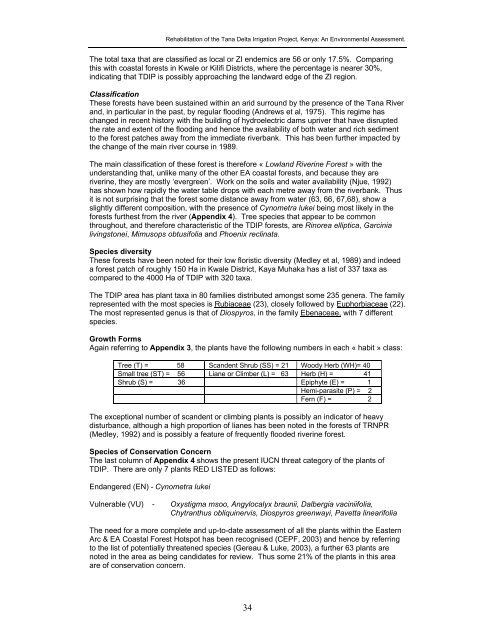Tana Delta Irrigation Project, Kenya: An Environmental Assessment
Tana Delta Irrigation Project, Kenya: An Environmental Assessment
Tana Delta Irrigation Project, Kenya: An Environmental Assessment
Create successful ePaper yourself
Turn your PDF publications into a flip-book with our unique Google optimized e-Paper software.
Rehabilitation of the <strong>Tana</strong> <strong>Delta</strong> <strong>Irrigation</strong> <strong>Project</strong>, <strong>Kenya</strong>: <strong>An</strong> <strong>Environmental</strong> <strong>Assessment</strong>.<br />
The total taxa that are classified as local or ZI endemics are 56 or only 17.5%. Comparing<br />
this with coastal forests in Kwale or Kilifi Districts, where the percentage is nearer 30%,<br />
indicating that TDIP is possibly approaching the landward edge of the ZI region.<br />
Classification<br />
These forests have been sustained within an arid surround by the presence of the <strong>Tana</strong> River<br />
and, in particular in the past, by regular flooding (<strong>An</strong>drews et al, 1975). This regime has<br />
changed in recent history with the building of hydroelectric dams upriver that have disrupted<br />
the rate and extent of the flooding and hence the availability of both water and rich sediment<br />
to the forest patches away from the immediate riverbank. This has been further impacted by<br />
the change of the main river course in 1989.<br />
The main classification of these forest is therefore « Lowland Riverine Forest » with the<br />
understanding that, unlike many of the other EA coastal forests, and because they are<br />
riverine, they are mostly ‘evergreen’. Work on the soils and water availability (Njue, 1992)<br />
has shown how rapidly the water table drops with each metre away from the riverbank. Thus<br />
it is not surprising that the forest some distance away from water (63, 66, 67,68), show a<br />
slightly different composition, with the presence of Cynometra lukei being most likely in the<br />
forests furthest from the river (Appendix 4). Tree species that appear to be common<br />
throughout, and therefore characteristic of the TDIP forests, are Rinorea elliptica, Garcinia<br />
livingstonei, Mimusops obtusifolia and Phoenix reclinata.<br />
Species diversity<br />
These forests have been noted for their low floristic diversity (Medley et al, 1989) and indeed<br />
a forest patch of roughly 150 Ha in Kwale District, Kaya Muhaka has a list of 337 taxa as<br />
compared to the 4000 Ha of TDIP with 320 taxa.<br />
The TDIP area has plant taxa in 80 families distributed amongst some 235 genera. The family<br />
represented with the most species is Rubiaceae (23), closely followed by Euphorbiaceae (22).<br />
The most represented genus is that of Diospyros, in the family Ebenaceae, with 7 different<br />
species.<br />
Growth Forms<br />
Again referring to Appendix 3, the plants have the following numbers in each « habit » class:<br />
Tree (T) = 58 Scandent Shrub (SS) = 21 Woody Herb (WH)= 40<br />
Small tree (ST) = 56 Liane or Climber (L) = 63 Herb (H) = 41<br />
Shrub (S) = 36 Epiphyte (E) = 1<br />
Hemi-parasite (P) = 2<br />
Fern (F) = 2<br />
The exceptional number of scandent or climbing plants is possibly an indicator of heavy<br />
disturbance, although a high proportion of lianes has been noted in the forests of TRNPR<br />
(Medley, 1992) and is possibly a feature of frequently flooded riverine forest.<br />
Species of Conservation Concern<br />
The last column of Appendix 4 shows the present IUCN threat category of the plants of<br />
TDIP. There are only 7 plants RED LISTED as follows:<br />
Endangered (EN) - Cynometra lukei<br />
Vulnerable (VU) - Oxystigma msoo, <strong>An</strong>gylocalyx braunii, Dalbergia vaciniifolia,<br />
Chytranthus obliquinervis, Diospyros greenwayi, Pavetta linearifolia<br />
The need for a more complete and up-to-date assessment of all the plants within the Eastern<br />
Arc & EA Coastal Forest Hotspot has been recognised (CEPF, 2003) and hence by referring<br />
to the list of potentially threatened species (Gereau & Luke, 2003), a further 63 plants are<br />
noted in the area as being candidates for review. Thus some 21% of the plants in this area<br />
are of conservation concern.<br />
34

















